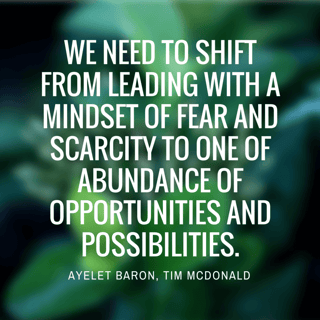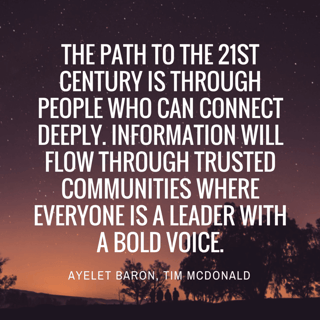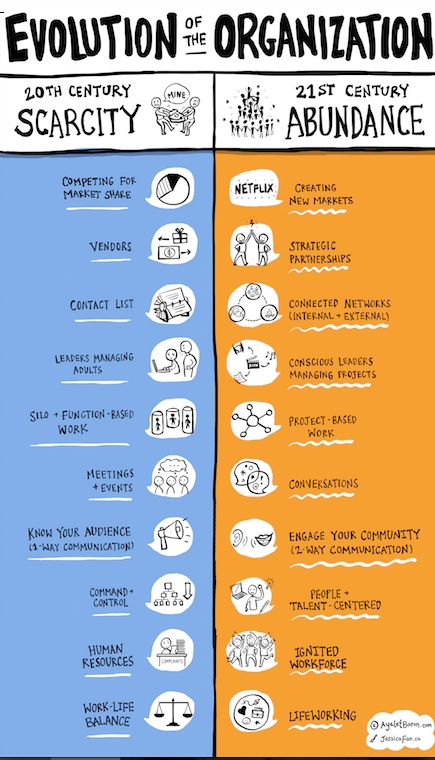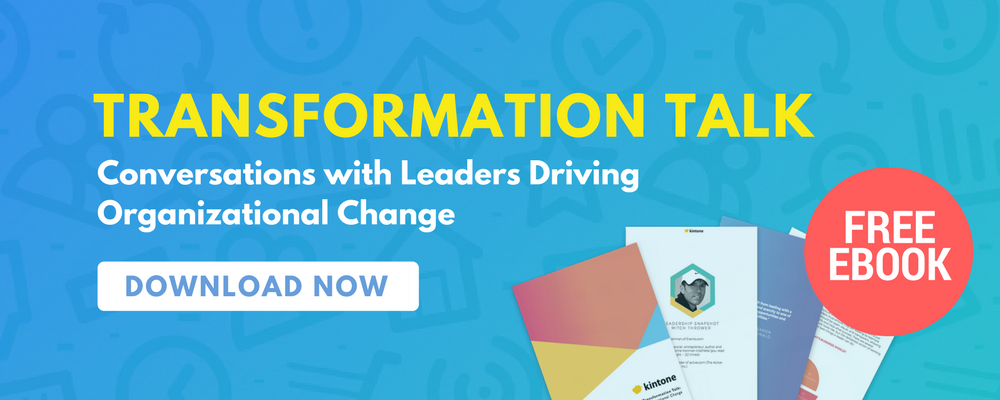There are many shades of change and for this week's Transformation Talk, we're talking to two visionaries with fluid careers that have served as a canvas for exploring meaningful change and organizational-wide transformation.
Ayelet Baron and Tim McDonald have done their share of co-creating and change.
Tim is the former director of community at the Huffington Post and also ran the No Kid Hungry campaign with amazing results and transformation. Ayelet is the former chief strategy and innovation officer for Cisco Canada and helped take Canada from the 6th revenue generating country to #2 in two years. She was also a global executive at Cisco for over 13 years and worked around the globe. Ayelet and Tim have a new book coming out for 21st century leaders.
Ayelet, tell us about the concept behind Our Journey To Business Common Sense and what led you to write this book?
AB: Our Journey to Business Common Sense is a journey of possibilities for the 21st century leader who wants to create a new path for business as a force of good in the world. The book shares real life stories of 21st century leaders who are living and working in new ways. It invites you to fire up your imagination, discover your own pathways, and tap into your own journey. It's written for all 21st leaders who want to understand how to thrive in this ever changing world and create healthy, people-centric organizations.
If you’re someone who doesn’t fit in a box — whether you’re an entrepreneur or employee — you will benefit from looking at the world through a new prism. One where human values triumph. This book is a journey for those who love to travel. You will receive an itinerary, a travelogue that asks you to leave your limiting beliefs behind. There are three legs to the journey and twelve expeditions to explore. There is no need to fasten your seat belt or know where the oxygen mask is. It’s for people who want to join us in this journey of co-creating a new path for business and people in this century.

I have been blessed to have a very successful career working around the globe. My work took me to almost every continent around the world to experience how people worked and lived. It helped me appreciate technology as an enabler to connecting people to people and how far we were for integrating it into business practices.
Through this work, I saw first hand how we were existing in a 21st century world and yet still using antiquated business practices such as fear, scarcity and competition. After leaving Cisco as Chief Strategy and Innovation officer for Cisco Canada, I spent a year as an innovator in residence with Roche/Genentech’s Strategic Innovation team, introducing new ways of working. Through my speaking, it became apparent to me that an increasing number of people are looking for more meaning in their lives and work. I started looking at the evolution of the organization and I felt a calling to write a book. After a journey to the Amazon Rainforest, my purpose became clear to me that I am here to be an author, a speaker and an activist for the human spirit. This is why I wrote this book. I feel deeply that it is time to co-create a new path for business in the world as a force of good.
Tim, how did your experience as Director of Community at Huffington Post lead you to the nonprofit sector?
TM: Although I was speaking before Huffington Post, I received more invites to speak due to who I worked for. This brought me to a restaurant industry event in Dallas where I was asked to speak at a Changers of Commerce session. I had not idea what to expect and had to follow people like Kat Cole, Jeff Power and Jessica Miller-Merrell, all who told amazing stories and had decks to go with them. When I was asked if I was ready, I got up, not knowing what I was going to say. I started with the fact that I didn’t know what I was in for and didn’t have a story to share, but what I did have was the connections, communities and platforms to help share other people’s stories. That lead the agency working on the No Kid Hungry account to ask me to join their Social Council.
What do you both consider broken in today’s business world?
In the business world today, the systems are starting to crack. We need to shift from leading with a mindset of fear and scarcity to one with an abundance of opportunities and possibilities. We are living in a world that is seeking short-term solutions instead of doing the work. So many organizations are too busy chasing someone else’s best practices to find out what works for them. We have over complicated business on so many levels, and we have an opportunity to simplify and bring the team back together to deliver on an organization’s purpose.
Business is new and this is the first time in our history that business and society are fusing, which opens us to regain our common sense and create people-centered organizations. We want leaders to recognize that we have shifted from the industrial era, where we had laborers, to the knowledge era, where we had experts and managed data, to today's human-to-human purpose and experience driven era, where people are at the heart of business.
The three most important currencies for the 21st century are trust, relationships and community. In 2016, we are still segmenting people who are important to our business into stakeholders and audiences in most one-way communication plans, when we have the opportunity to connect, collaborate, and co-create with them in meaningful dialogue.
What are the seven signposts of the 21st century that you believe should be guiding our organizations?
To thrive in the 21st century, our journey includes:
#1 — Conscious 21st Century Society and Business Leadership: The 21st century leader sees business as the most powerful man-made force yet created. It is a bridge to a more shared doable prosperity for everyone; not for the few that control the shares. Everyone is a leader in the 21st century. We know how to bring people together around shared purpose and work without constant supervision and control. A 21st century leader works out loud and builds community around the world. We value two-way conversations and spend more time connecting people than managing them.
 #2 — Meaning Making and Shared Purpose: We have been given a safe box that we were conditioned to live in and many people today of all ages are seeking meaning and purpose beyond the confines of the box by either asking new questions or remembering our voices. Instead of creating a brand message, we can simply start by doing the work of understanding who we are, why we are here and who we can create and co-create with purpose and meaning. It’s so simple that it gets lost in translation as we are enamored by shiny new objects and complexity
#2 — Meaning Making and Shared Purpose: We have been given a safe box that we were conditioned to live in and many people today of all ages are seeking meaning and purpose beyond the confines of the box by either asking new questions or remembering our voices. Instead of creating a brand message, we can simply start by doing the work of understanding who we are, why we are here and who we can create and co-create with purpose and meaning. It’s so simple that it gets lost in translation as we are enamored by shiny new objects and complexity
#3 — Becoming Whole, Again, as Individuals and Organizations: What is possible in our world is natural and becoming whole connects us to the rhythm of nature. It is time for us to become whole as individuals and organizations by remembering how connected every being on the planet is. For the first time in the history of humanity, any person with a device, connectivity and power can connect with billions of people who are online. It allows us to see beyond geographies and do great work in a way that makes an impact. It is time for harmony and wholeness as 21st century leaders bring people together around shared purpose to create something bigger than themselves.
FREE DOWNLOAD: Transformation Blueprint To Facilitate Change In Your Life & Company
#4 — It’s All About People: It’s Time to Integrate the Team. It is time to break down the walls of separation. In the 21st century, work is organized around small autonomous teams that come together as needed. As you have access to the best people in the world, you can build a team that will help achieve your purpose. And remember that an increasing number of people, who pick themselves, see their working life structured around short-term, project based teams rather than long-term jobs. There is greater demand for open, two-way conversations in lieu of hierarchy or dogmatism
#5 — New Ways of Working: The journey allows us to be present to experience life in new ways. Living in an open and connected world is a privilege that many are just starting to recognize. It involves self-reflection and a new definition of vulnerability as we share more openly and connect more easily. The era of the expert and the knowledge are transforming into the human-to-human purpose and experience driven era, where people matter. The less we talk about technology and the more we focus on its value in driving our purpose, the more we will be able to live and work in greater harmony and actualize its potential for business. We will recognize that by turning on our video camera, for example, there is a person on the other side of the screen that we can connect with deeply. We will get a bit confused about what “in person” means as we will spend more time connecting with people from around the world virtually and create deep lasting relationships.
# 6 — Co-creating in Abundance; Connected Networks, Trusted Communities and Unlikely Partnerships: The path to the 21st century is through people who can connect deeply. Information will flow through trusted communities where everyone is a leader with a bold voice. We treat each other with respect and dignity as we no longer look to the top for approval and recognition in our post-hero society. This new way of co-creating allows us to find unlikely partners to go to market with and create something bigger than ourselves. When we focus on purpose, we will connect with people who will help us enter new markets.
#7 — Becoming A Lifeaholic in a World of LIFEworking: it’s time to free ourselves from old ways of thinking that no longer serve us. Imagine that life is one big adventure where work is just a part of it. We are whole people wanting whole lives, with passion, meaning and purpose. We were not born to pursue the mythical work-life balance. There is only life. More people of all ages are starting to make different choices and walk away from a stressful way of life.
 What can leaders do daily to drive change at their organizations?
What can leaders do daily to drive change at their organizations?
We need to stop trying to manage change and introduce new programs. It’s time to have a clear purpose and have people understand their role in it. If we hire the best and brightest, we need to start treating them by giving them access to leaders and information. Having worked on major large scale change projects for many years, we need to simply improve communication, rebuild trust in enterprises and practice more dialogue. We need to give leaders the permission to lead.
What makes a good change leader?
The ability to listen, show vulnerability and be transparent. Adults don’t need to be managed; projects do. A 21st century leader knows how to bring the right people to focus on opportunities and create shared purpose. They know how to create the space for the conversations to emerge. They are also great storytellers.
What are some of the biggest barriers to change in an organization?
- Scarcity mindsets of fear.
- Hierarchical leadership.
- The constant introduction of change initiatives that seem to be the flavor of the month.
- Lack of leadership.
What skills do you think will be of utmost importance in the future workplace?
Trust, Empathy, Relationships and Community
The easiest way to approach community is to stop talking and start listening. It’s that simple. It's about listening to people around you; not just the ones sitting right next to you. We need to be listening to people that are in different departments internally. We need to be listening to people in different offices. We need to be listening to our customers and not just our top customers who are on all the advisory boards. But also the ones who might buy your product once and never buy it again. We need to be talking to the ones that are maybe not your highest volume customers but the ones who are the most passionate about your brand.
When you start looking at all these people and listen to what they're saying, that's how you can start to begin to build community. And why is that important? Because we're not living in a world where you can run a focus group and then develop a product based on the research. By the time you do that, it's obsolete.
We are in a world where we can let the community tell us instead of us guessing what we think they want. The biggest problem today is that we're too busy and too concerned thinking we have all the answers, instead of just admitting that we don't. We listen to what people are responding to us with, and then building on top of that together, instead of just having it be us pushing out a product. It's now a two-way communication where we're both creating it together.
Do you know someone who’s particularly fantastic at business transformation? Is a master of change management? A leader in teamwork? Nominate them — or better yet, nominate yourself (c’mon now, you’re awesome!) to be featured in our Transformation Talk series.
Just send Nicole an email: nicole@kintone.com
Or send us a message on Twitter @Kintone
About the Author
Nicole is Director of Marketing at Kintone, with 10+ years experience in content strategy, campaign management, lead acquisition and building positive work cultures of empowered, purpose-driven team members. She spent seven years as a journalist, previously serving as a CBS San Francisco digital producer, NPR contributor, Patagon Journal deputy editor and reporter for several publications, including the Chicago Tribune. She's passionate about the tech for good space, social entrepreneurship and women leadership. On the weekends, you’ll likely find her putting her Master Gardener skills to use in at community gardens in Oakland.












